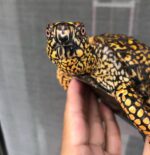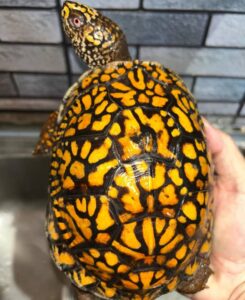Description
The eastern box turtle for sale (Terrapene carolina carolina) is a subspecies within a group of hinge-shelled turtles normally called box turtles. T. c. carolina is native to the Eastern United States.
This turtle is a subspecies of the common box turtle (Terrapene carolina). While in the pond turtle family, Emydidae, and not a tortoise, the box turtle is largely terrestrial. Box turtles are slow crawlers, extremely long-lived, and slow to mature and have relatively few offspring per year. These characteristics, along with a propensity to get hit by cars and agricultural machinery, make all box turtle species particularly susceptible to anthropogenic, or human-induced, mortality.
In 2011, citing “a widespread persistent and ongoing gradual decline of Terrapene carolina that probably exceeds 32% over three generations”, the International Union for Conservation of Nature (IUCN) downgraded its conservation status from near threatened to vulnerable.
Description of eastern box turtle
Eastern box turtles have a high, domelike carapace and a hinged plastron that allows total shell closure. Their shell has a middorsal keel that smooths out with age. The carapace can be of variable coloration but is normally brownish or black and accompanied by a yellowish or orangish radiating pattern of lines, spots, or blotches.
Skin coloration, like that of the shell, is variable but is usually brown or black with some yellow, orange, red, or white spots or streaks. This coloration closely mimics that of the winter leaf of the tulip poplar.
In some isolated populations, males may have blue patches on their cheeks, throat, and front legs. Furthermore, males normally possess red eyes (irises), whereas females usually have brown eyes. Eastern box turtles feature a sharp, horned beak and stout limbs, and their feet are webbed only at the base. Eastern box turtles have five toes on each front leg and normally four toes on each hind leg, although some individuals may possess three toes on each hind leg. Eastern box turtles range in size from 4.5 to 8 in (11 to 20 cm) long.

Eastern box turtle for sale have many uniquely identifying characteristics as part of the box turtle group. While the female’s plastron is flat, it is concave in males so the male may fit over the back end of the female’s carapace during mating. The front and back of the plastron are connected by a flexible hinge.
When in danger, the turtle is able to close the plastron by pulling the hinged sections closely against the carapace, effectively sealing the soft body in bone, hence forming a “box”. The shell is made of bone covered by living vascularized tissue and covered with a layer of keratin. This shell is connected to the body through its fused rib cage which makes the shell permanently attached and not removable.
Behaviors
As ectotherms, Eastern box turtles must maintain temperature homeostasis by seeking cover, such as shaded forests or streams, when body temperatures are high and by finding basking locations when body temperatures are low, in order to increase their metabolic rate for foraging and digestion






















Dani –
Very happy with health and quality of animals I received, they were delivered promptly, packaged well and very healthy ,I will defenitly order from you again.
Jenny –
He came over night and he is PERFECT! One of the most gorgeous little guys I have ever seen! So lively and curious!.
Lopez –
Excellent customer service 💯
Hector –
Ordered 6 hatchlings and all of them are still doing great 👍